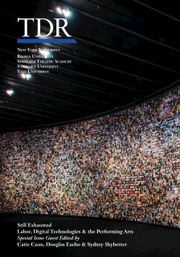No CrossRef data available.
Article contents
“It caught me”
Dance, Possession, and Revolt
Published online by Cambridge University Press: 05 September 2025
Abstract
Bodies in possession and in revolt are often framed as being “caught” by some other entity—a spirit, a force, or a memory. Cases of rebellion involve a loss of intentionality of movement, unlike a subject who wills and decides. What is the political significance of the illegibility of such movements, before they are consigned to taxonomies and diagnoses that render them pathological, criminal, or demonic? What thinking about dance might this permit?
Information
- Type
- Article
- Information
- TDR , Volume 69 , Issue 3: Performance, Possession, and Automation Brown University TDR Consortium Issue , September 2025 , pp. 160 - 170
- Copyright
- © The Author(s), 2025. Published by Cambridge University Press on behalf of New York University Tisch School of the Arts
References
References
Arendt, Hannah. (1950) 2005. The Promise of Politics, ed. Jerome Kohn. Schocken Books.Google Scholar
Derman, Özge. 2019. “Public Performance as Personal Resistance: ‘Standing Man’ in Taksim.” Politika, 24 May. doi.org/10.26095/xnhf-cp74
Google Scholar
Ertem, Gurur. 2017. “Gezi Uprising: Performative Democracy and Politics of the Body in an Extended Space of Appearance.” In Media Practices, Social Movements, and Performativity: Transdisciplinary Approaches, ed.CrossRefGoogle Scholar
Foellmer, Susanne, Lünenborg, Margreth, and Raetzsch, Christoph, 81–99. Routledge. doi.org/10.4324/9781315455938
Google Scholar
Fanon, Frantz. (1961) 1968. The Wretched of the Earth. Trans. Constance Farrington. Grove Press.Google Scholar
Georgelou, Konstantina, and Gündüz, Erdem. 2019. “Post-Dance-Ing.” For POST-DANCE-ING conference, MDT Stockholm. mdtsthlm.se/off-stage/symposier/post-dance-ingGoogle Scholar
Harney, Stefano, and Moten, Fred. 2013. The Undercommons: Fugitive Planning and Black Study. Minor Compositions.Google Scholar
Kazim, Hasnain. 2013. “The Standing Man Says More Must Be Done.” Spiegel International, 5 September. www.spiegel.de/international/world/profile-of-turkish-protest-movemet-icon-erdem-guenduez-a-920577.html
Google Scholar
Keller, Mary. 2002. The Hammer and the Flute: Women, Power and Spirit Possession. Johns Hopkins University Press.Google Scholar
Lepecki, André. 2013. “Choreopolice and Choreopolitics: or, the task of the dancer.” TDR 57, 4 (T220):13–27. doi.org/10.1162/DRAM_a_00300
CrossRefGoogle Scholar
Mee, Erin B. 2014. “Standing Man and the Impromptu Performance of Hope: An Interview with Erdem Gündüz.” TDR 58, 3 (T223):69–83. doi.org/10.1162/DRAM_a_00373
CrossRefGoogle Scholar
Moten, Fred. 2008. “The Case of Blackness.” Criticism 50, 2:177–218. doi.org/10.1353/crt.0.0062
CrossRefGoogle Scholar
Ong, Aihwa. 2010. Spirits of Resistance and Capitalist Discipline: Factory Women in Malaysia. 2nd ed. State University of New York.CrossRefGoogle Scholar
Öztürkmen, Arzu, and Birge Vitz, Evelyn, eds. 2014. Medieval and Early Modern Performance in the Eastern Mediterranean. Brepols Publishers.CrossRefGoogle Scholar
Schwartz, Hillel. 1992. “Torque: The New Kinaesthetic of the Twentieth Century.” In Incorporations, ed. Crary, Jonathan and Kwinter, Sanford, 71–127. Zone 6. MIT Press.Google Scholar
Scott, James C. 1999. Seeing Like a State: How Certain Schemes to Improve the Human Condition Have Failed. Yale University Press.Google Scholar
Seymour, Richard. 2013. “Turkey’s ‘Standing Man’ Shows How Passive Resistance Can Shake a State.” Guardian, 18 June. www.theguardian.com/commentisfree/2013/jun/18/turkey-standing-man
Google Scholar
Spångberg, Mårten. 2017. “Post-dance, An Advocacy.” In Post-Dance, ed. Andersson, Danjel, Edvardsen, Mette, Spångberg, Mårten, 349–93. MDT.Google Scholar
Assche, Van, Annelies, and Schaffer, Kareth. 2023. “Flexible Performativity: What Contemporary Dancers Do When They Do What They Do.” TDR 67, 1 (T257):203–22. doi.org/10.1017/S1054204322000922
Google Scholar
Verstraete, Pieter. 2013. “The Standing Man Effect.” IPC-Mercator Policy Brief. Sabancı University.Google Scholar
Waller, John. 2009. The Dancing Plague: The Strange, True Story of an Extraordinary Illness. Sourcebooks.Google Scholar
TDReadings
Lepecki, André. 2013. “Choreopolice and Choreopolitics: or, the task of the dancer.” TDR 57, 4 (T220):13–27. doi.org/10.1162/DRAM_a_00300CrossRefGoogle Scholar
Mee, Erin B. 2014. “Standing Man and the Impromptu Performance of Hope: An Interview with Erdem Gündüz.” TDR 58, 3 (T223):69–83. doi.org/10.1162/DRAM_a_00373CrossRefGoogle Scholar
Van Assche, Annelies, and Schaffer, Kareth. 2023. “Flexible Performativity: What Contemporary Dancers Do When They Do What They Do.” TDR 67, 1 (T257):203–22. doi.org/10.1017/S1054204322000922CrossRefGoogle Scholar

